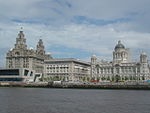
The Philharmonic Dining Rooms is a public house at the corner of Hope Street and Hardman Street in Liverpool, Merseyside, England, and stands diagonally opposite the Liverpool Philharmonic Hall. It is commonly known as The Phil. It is recorded in the National Heritage List for England as a designated Grade I listed building.
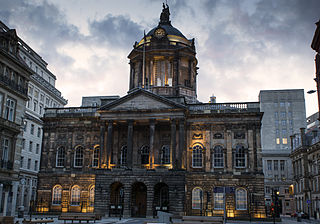
Liverpool Town Hall stands in High Street at its junction with Dale Street, Castle Street, and Water Street in Liverpool, Merseyside, England. It is recorded in the National Heritage List for England as a designated Grade I listed building, and described in the list as "one of the finest surviving 18th-century town halls". The authors of the Buildings of England series refer to its "magnificent scale", and consider it to be "probably the grandest ...suite of civic rooms in the country", and "an outstanding and complete example of late Georgian decoration".

The Bank of England Building is a Grade I listed building located on Castle Street, Liverpool, England.
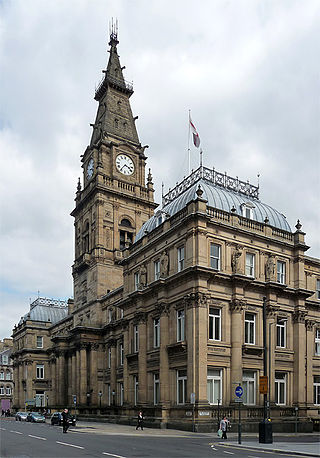
Municipal Buildings is a former council office building that has been converted into a hotel. It is located on Dale Street in the centre of Liverpool, England. It is a Grade II* listed building.

Tower Buildings is a former office block in the city of Liverpool, Merseyside, England. It stands with its longer front on the east side of the Strand, and extends round the corner into Water Street. The building is located directly opposite the Royal Liver Building, which was designed by the same architect. Earlier buildings on the site have been a sandstone mansion, and a later fortified house known as the Tower of Liverpool. After this was demolished in 1819, it was replaced in 1846 by the first structure to be named Tower Buildings. The present structure is one of the earliest steel-framed buildings in England, and details of its architecture reflect the earlier fortified building on the site. It is a building

The Portico Library, The Portico or Portico Library and Gallery on Mosley Street in Manchester, England, is an independent subscription library designed in the Greek Revival style by Thomas Harrison of Chester and built between 1802 and 1806. It is recorded in the National Heritage List for England as a Grade II* listed building, having been designated on 25 February 1952, and has been described as "the most refined little building in Manchester".

The Aloft Liverpool Hotel, formerly the Royal Insurance Building, is a historic building located at 1-9 North John Street, Liverpool, Merseyside, England. It was built as the head office of the Royal Insurance company.

Blackburne House is an 18th-century Grade II listed building located on the east side of Hope Street, Liverpool, Merseyside, England. It was built in 1788 and remodelled in from 1874 to 1876. Originally a private house, it became a girls' school and, after a period of dereliction, it is now used as a training and resource centre for women.

2–18 St Werburgh Street is a terrace consisting of a bank, shops and offices on the east side of St Werburgh Street and the north side of Eastgate Street, Chester, Cheshire, England. The terrace is recorded in the National Heritage List for England as a designated Grade II* listed building.

3–31 Northgate Street is a terrace of shops, offices and a public house on the west side of Northgate Street, Chester, Cheshire, England. All the buildings have a set-back ground floor with a covered walkway, are timber-framed in their upper storeys, and are listed buildings, being graded II* or II. The part of the terrace comprising numbers 5–31 is known as Shoemakers' Row, or Sadler's Row.
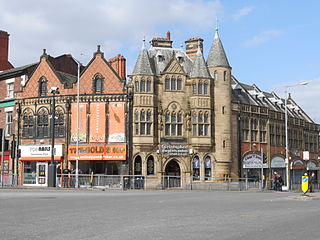
Bank Buildings is a historical construction on a corner site at 1–7 Charing Cross, Birkenhead, Wirral, Merseyside, England. It consists of offices and shops which extend towards the north along Exmouth Street and towards the west along Grange Road West. It is recorded in the National Heritage List for England as a designated Grade II listed building.

The Radisson RED Liverpool Hotel is a historic building in Liverpool, England. It is located on the east side of Lime Street, fronting Lime Street railway station. Opened in 1871 as the North Western Hotel, it more recently served as office space and student accommodation. It was restored to a hotel from 2018 to 2022. The building is recorded in the National Heritage List for England as a designated Grade II listed building.
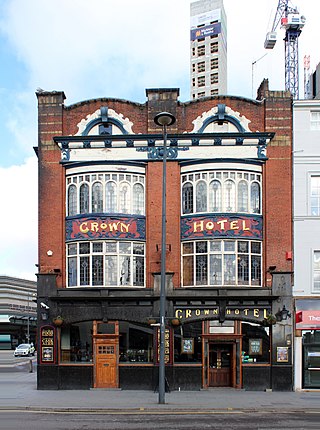
The Crown Hotel is a public house on Lime Street, Liverpool, England. It is recorded in the National Heritage List for England as a designated Grade II listed building.

Hargreaves Building is a former bank in Chapel Street, Liverpool, Merseyside, England. It originated as the headquarters of the Brown Shipley Bank, continued as offices when the bank moved to London, was converted for use by the Liverpool Racquet Club after the Toxteth riots, and later became a hotel and restaurant.

The State Insurance Building is at 14 Dale Street, Liverpool, Merseyside, England. Half of the building was destroyed by bombing in the Second World War. Both its external architecture and its internal decoration are elaborate.

The Temple is an office building at 22A and 24 Dale Street, Liverpool, Merseyside, England.

The Church of St Vincent de Paul is a Roman Catholic parish church in Park Lane, Liverpool, England. It is an active parish church in the Archdiocese of Liverpool and the Pastoral Area of Liverpool South. The church is recorded in the National Heritage List for England as a designated Grade II* listed building.

The Atkinson is a building on the east side of Lord Street extending round the corner into Eastbank Street, Southport, Sefton, Merseyside, England. The building is a combination of two former buildings, the original Atkinson Art Gallery and Library that opened in 1878, and the adjacent Manchester and Liverpool District Bank that was built in 1879. These were combined in 1923–24 and the interiors have been integrated. The original building is in Neoclassical style, and the former bank is in Renaissance style.

The Church of St Teresa of Avila in Everton Road, Birkdale, Southport, Sefton, Merseyside, England, is an active Roman Catholic church in the diocese of Liverpool. It was built in 1897–98 and designed by the architectural partnership of James Sinnott, Bernard Sinnott & Daniel Powell. The church, together with its attached presbytery, is recorded in the National Heritage List for England as a designated Grade II listed building.

Ince Blundell Hall is a former country house near the village of Ince Blundell, in the Metropolitan Borough of Sefton, Merseyside, England. It was built between 1720 and 1750 for Robert Blundell, the lord of the manor, and was designed by Henry Sephton, a local mason-architect. Robert's son, Henry, was a collector of paintings and antiquities, and he built impressive structures in the grounds of the hall in which to house them. In the 19th century the estate passed to the Weld family. Thomas Weld Blundell modernised and expanded the house, and built an adjoining chapel. In the 1960s the house and estate were sold again, and have since been run as a nursing home by the Canonesses of St. Augustine of the Mercy of Jesus.






















